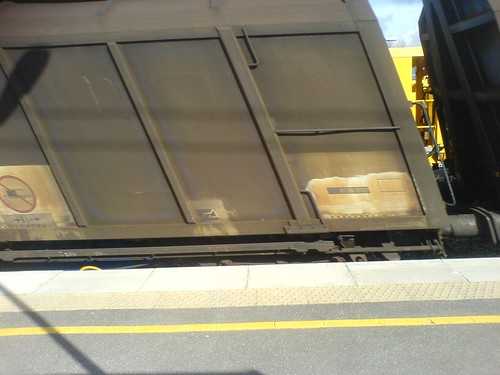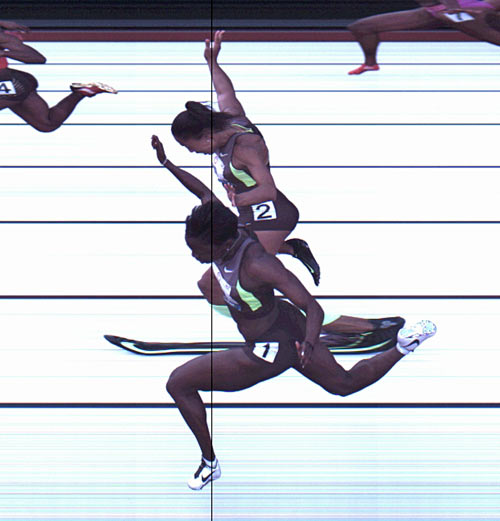A reader writes:
What the hell is going on in this "photo finish" picture?
Two sprinters are perfectly tying for third place and creating new track and field rules, but what I mean is what's going on with runner #2's Sideshow Bob foot, and runner #1's Rob Liefeld foot. Runner #7 in the background looks pretty weird, too.
According to the New York Times, "the finish line cameras capture up to 3,000 frames per second". Do all of those frames look like this?!
TimT
The obvious way to implement a finish-line camera is, as the NYT say, to just run a movie camera at a huge number of frames per second.
This is not actually how most finish-line cameras work, though, primarily because of how shutters work.
A perfect camera shutter uncovers the film or sensor all at once, stays open for however long it's supposed to, then blocks the light, again all at once. You can try to implement something that works like this in electronics, or evade the problem by opening the shutter with the subject in darkness, briefly illuminating the subject with a high-speed flash, and then closing the shutter in darkness again. But that's no use for everyday photography or photo finishes, and making a physical object that works as an ideal shutter is pretty much impossible.
Instead, still and video shutters are implemented with "curtains", sliding plates, rotating discs, and various other things, none of which behave much like an ideal shutter when you need very brief exposure times, as is necessary if you need to see which runner, horse or car got over the line a hundredth of a second before the next one.
Most all-electronic cameras don't come anywhere near having an ideal shutter, either. Instead, they have a "rolling shutter" that scans across the frame, line by line or column by column, in a short but distinctly non-zero amount of time.
Rolling shutters aren't great for video, because things moving across the frame - because they and/or the camera are moving - will be in a different place as each new line or column of the frame is detected. This creates distinctive forms of distortion.
A rolling shutter will cause things that move through the frame relatively slowly to...

(source)
...display a distinctive slant.
Things moving very quickly, like aircraft propeller blades, look far more disturbing if the exposure time is short enough that they aren't just a blur:

(source)
Seeing this in motion doesn't help:
(source)
OK, so here we have examples of distortion created because the "hole" that lets light into the camera is changing in size, shape and location over a long enough period of time that it visibly interacts with moving objects in the scene being photographed. This is bad for everyday photography, when you don't want things you're shooting to look weird.
Looking weird is acceptable in finish-line photos, though, as long as you know what the weirdness means. The picture can be as freaky and distorted as you like, as long as you can tell who got to the finishing line first. (Or, in the case of the picture you're asking about, who got there third. Third place was, in this race, good enough to qualify the runner who got it for a place in this year's US Olympic team.)
For this reason, most finish-line cameras aren't super-high-speed movie cameras, but instead a kind of slit camera. A slit camera has a line-shaped lens, which exposes the film or electronic sensor line by line or column by column, not unlike the way a rolling shutter works. The critical difference, though, is that a slit camera can keep on going indefinitely. You can keep collecting image data, or keep spooling film past the slit, for as long as you have memory or film. The shutter never closes as long as the film or memory lasts, so it's impossible to miss any action between the frames.
Flatbed scanners are a kind of slit camera, and with modification can in fact be used as one; anything that moves around while the scan's being made, though, will look distorted. Move an object in the oppposite direction of the scanner head's motion, and that object will look shorter than it really is. Move it in the same direction, and it'll look longer. (Move it at the exact same speed as the scanner head, and the scanner will just keep seeing the same bit of the object for the whole scan, making the object look like an endless stripe.)
OK, so now imagine taking a flatbed scanner sensor and setting it up vertically, looking across a racetrack at the finish line. Start a "scan", and it'll authoritatively tell you when every body-part of every runner makes it to the finish, by simply showing that part of that person before any part of anyone else. The speed of the scan should be set to roughly match the speed of the runners, so they look generally the right shape, but any part of any runner that stays stationary relative to the scan rate - a foot on the ground, for instance - will seem long. Any part that's moving forward relative to the scan rate - a hand or foot coming forward, for instance - will seem short. Even if you mess up the scan rate so everyone looks wide or narrow, whatever part of whatever runner shows up first in the scan is the first to cross the finish line.
So let's look at this picture again. You can see that runner #4 got second place (whoever got first is off to the left somewhere), and #7 in the background is going to get fifth. Runner #2's foot got to the finish first, and because it was then planted on the ground it looks ridiculously elongated. Runner #1's left foot was moving forward as it crossed the line, and so it's shrunk.
Unfortunately for #2, the foot doesn't count. To win, your torso has to cross the line first. #2 has the first foot, #1 has the first hand and then knee, #2 has the first head... and then the foremost part of each of their torsos hits the line, so far as can be seen, at exactly the same time.
Here's some more about practical and artistic uses of photo-finish cameras; there's a Wikipedia article as well, of course. Slit-scan techniques have often been used to create strange visual effects, like Doctor Who intros and the trippy bit in 2001.
Psycho Science is a regular feature here. Ask me your science questions, and I'll answer them. Probably.
And then commenters will, I hope, correct at least the most obvious flaws in my answer.

26 June 2012 at 10:48 pm
As used to spellbinding effect in the video for Muse - Unintended: http://www.youtube.com/watch?v=i9LOFXwPwC4